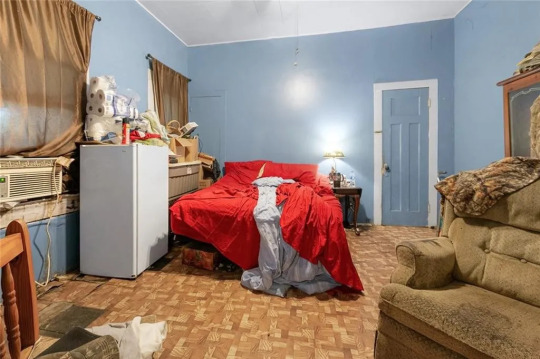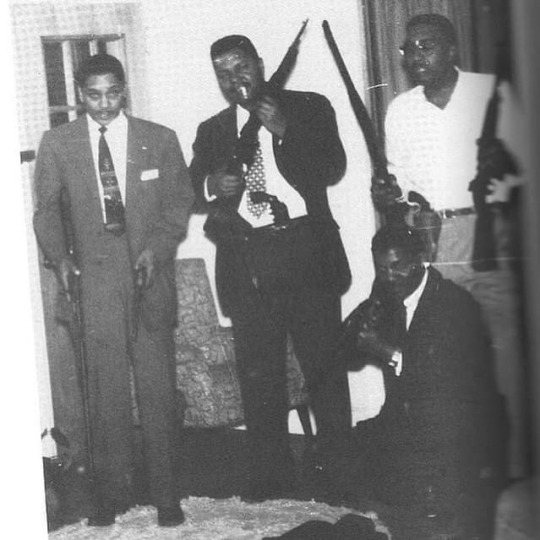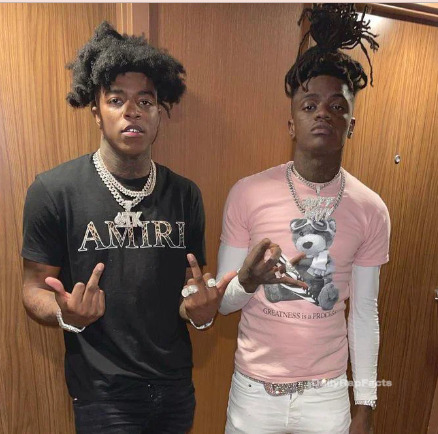#bogalusa
Explore tagged Tumblr posts
Text

W 5th Street, Bogalusa, Louisiana.
20 notes
·
View notes
Photo

#mardigras #mardigras2023 #fattuesday #nola #bogalusa #louisiana #howlinwulfpress (at Bogalusa, Louisiana) https://www.instagram.com/p/CmVCzwou8yD/?igshid=NGJjMDIxMWI=
0 notes
Text
I just know the poor bastards over at that paper mill were praying to get covid and lose their smell
2 notes
·
View notes
Text

The Deacons for Defense and Justice was an armed self-defense African-American civil rights organization in the U.S. Southern states during the 1960s. Historically, the organization practiced self-defense methods in the face of racist oppression that was carried out under the Jim Crow Laws by local/state government officials and racist vigilantes. Many times the Deacons are not written about or cited when speaking of the Civil Rights Movement because their agenda of self-defense - in this case, using violence, if necessary - did not fit the image of strict non-violence that leaders such as Dr. Martin Luther King Jr. espoused.
On July 10, 1964, a group of African American men in Jonesboro, Louisiana led by Earnest “Chilly Willy” Thomas and Frederick Douglas Kirkpatrick founded the group known as The Deacons for Defense and Justice to protect members of the Congress of Racial Equality (CORE) against Ku Klux Klan violence. Most of the “Deacons” were veterans of World War II and the Korean War. The Jonesboro chapter organized its first affiliate chapter in nearby Bogalusa, Louisiana led by Charles Sims, A.Z. Young and Robert Hicks. Eventually they organized a third chapter in Louisiana. The Deacons tense confrontation with the Klan in Bogalusa was crucial in forcing the federal government to intervene on behalf of the local African American community. The national attention they garnered also persuaded state and national officials to initiate efforts to neutralize the Klan in that area of the Deep South.
The Deacons emerged as one of the first visible self-defense forces in the South and as such represented a new face of the civil rights movement. Traditional civil rights organizations remained silent on them or repudiated their activities. They were effective however in providing protection for local African Americans who sought to register to vote and for white and black civil rights workers in the area. The Deacons, for example, provided security for the 1966 March Against Fear from Memphis to Jackson, Mississippi.
3 notes
·
View notes
Text
CHRONOLOGY OF AMERICAN RACE RIOTS AND RACIAL VIOLENCE p-5
1961 May First Freedom Ride. 1962 Harlem Youth Opportunities Unlimited (HARYOU) is founded. Robert F. Williams publishes Negroes with Guns, exploring Williams’ philosophy of black self-defense. October Two die in riots when President John F. Kennedy sends troops to Oxford,Mississippi, to allow James Meredith to become the first African American student to register for classes at the University of Mississippi. 1963 Publication of The Fire Next Time by James Baldwin. Revolutionary Action Movement (RAM) is founded. April Rev. Martin Luther King, Jr., writes his ‘‘Letter from Birmingham Jail.’’
June Civil rights leader Medgar Evers is assassinated in Mississippi. August March on Washington; Rev. King delivers his ‘‘I Have a Dream’’ speech before the Lincoln Memorial in Washington, D.C.
September Four African American girls—Carol Denise McNair, Cynthia Wesley, Carole Robertson, and Addie Mae Collins—are killed when a bomb explodes at theSixteenth Street Baptist Church in Birmingham, Alabama. 1964 June–August Three Freedom Summer activists—James Earl Chaney, Andrew Goodman, and Michael Schwerner—are arrested in Philadelphia, Mississippi; their bodies are discovered six weeks later; white resistance to Freedom Summer activities leads to six deaths, numerous injuries and arrests, and property damage acrossMississippi. July President Lyndon Johnson signs the Civil Rights Act. New York City (Harlem) riot. Rochester, New York, riot. Brooklyn, New York, riot. August Riots in Jersey City, Paterson, and Elizabeth, New Jersey. Chicago, Illinois, riot. Philadelphia, Pennsylvania, riot. 1965 February While participating in a civil rights march from Selma to Montgomery, Alabama, Jimmie Lee Jackson is shot by an Alabama state trooper. Malcolm X is assassinated while speaking in New York City. March Bloody Sunday march ends with civil rights marchers attacked and beaten by local lawmen at the Edmund Pettus Bridge outside Selma, Alabama. Lowndes County Freedom Organization (LCFO) is formed in Lowndes County,Alabama. First distribution of The Negro Family: The Case for National Action, better known as The Moynihan Report, which was written by Undersecretary of Labor Daniel Patrick Moynihan and Nathan Glazer. July Springfield, Massachusetts, riot. August Los Angeles (Watts), California, riot. 1965–1967 A series of northern urban riots occurring during these years, including disorders in the Watts section of Los Angeles, California (1965), Newark, New Jersey (1967), and Detroit, Michigan (1967), becomes known as the Long Hot Summer Riots. 1966 May Stokely Carmichael elected national director of the Student Nonviolent Coordinating Committee (SNCC). June James Meredith is wounded by a sniper while walking from Memphis, Tennessee, to Jackson, Mississippi; Meredith’s March Against Fear is taken up by Martin Luther King, Jr., Stokely Carmichael, and others. July Cleveland, Ohio, riot. Murder of civil rights demonstrator Clarence Triggs in Bogalusa, Louisiana. September Dayton, Ohio, riot. San Francisco (Hunters Point), California, riot. October Black Panther Party (BPP) founded by Huey P. Newton and Bobby Seale. 1967
Publication of Black Power: The Politics of Liberation by Stokely Carmichael and Charles V. Hamilton. May Civil rights worker Benjamin Brown is shot in the back during a student protest in Jackson, Mississippi. H. Rap Brown succeeds Stokely Carmichael as national director of the Student Nonviolent Coordinating Committee (SNCC). Texas Southern University riot (Houston, Texas). June Atlanta, Georgia, riot. Buffalo, New York, riot. Cincinnati, Ohio, riot. Boston, Massachusetts, riot. July Detroit, Michigan, riot. Newark, New Jersey, riot. 1968 Publication of Soul on Ice by Eldridge Cleaver. February During the so-called Orangeburg, South Carolina Massacre, three black college students are killed and twenty-seven others are injured in a confrontation with police on the adjoining campuses of South Carolina State College and Claflin College. March Kerner Commission Report is published. April Dr. Martin Luther King, Jr., is assassinated in Memphis, Tennessee. President Lyndon Johnson signs the Civil Rights Act of 1968. Washington, D.C., riot. Cincinnati, Ohio, riot. August Antiwar protestors disrupt the Democratic National Convention in Chicago. 1969 May James Forman of the SNCC reads his Black Manifesto, which calls for monetary reparations for the crime of slavery, to the congregation of Riverside Church in New York; many in the congregation walk out in protest. July York, Pennsylvania, riot. 1970 May Two unarmed black students are shot and killed by police attempting to control civil rights demonstrators at Jackson State University in Mississippi. Augusta, Georgia, riot. July New Bedford, Massachusetts, riot. Asbury Park, New Jersey, riot. 1973 July So-called Dallas Disturbance results from community anger over the murder of a twelve-year-old Mexican-American boy by a Dallas police officer. 1975–1976 A series of antibusing riots rock Boston, Massachusetts, with the violence reaching a climax in April 1976. 1976 February Pensacola, Florida, riot. 1980 May Miami, Florida, riot. 1981 March Michael Donald, a black man, is beaten and murdered by Ku Klux Klan members in Mobile, Alabama. 1982 December Miami, Florida, riot. 1985 May Philadelphia police drop a bomb on MOVE headquarters, thereby starting a fire that consumed a city block. 1986 December Three black men are beaten and chased by a gang of white teenagers in Howard Beach, New York; one of the victims of the so-called Howard Beach Incident is killed while trying to flee from his attackers. 1987 February–April Tampa, Florida, riots. 1989 Release of Spike Lee’s film, Do the Right Thing. Representative John Conyers introduces the first reparations bill into Congress—the Commission to Study Reparation Proposals for African Americans Act; this and all subsequent reparations measures fail passage. August Murder of Yusef Hawkins, an African American student killed by Italian-American youths in Bensonhurst, New York. 1991 March Shooting in Los Angeles of an African American girl, fifteen-year-old Latasha Harlins, by a Korean woman who accused the girl of stealing. Los Angeles police officers are caught on videotape beating African American motorist Rodney King. 1992 April Los Angeles (Rodney King), California, riot. 1994 Survivors of the Rosewood, Florida, riot of 1923 receive reparations. February Standing trial for a third time, Byron de la Beckwith is convicted of murdering civil rights worker Medgar Evers in June 1963.
18 notes
·
View notes
Text
Yungeen Ace wishes JayDaYoungan ‘did another album’ with him
Yungeen and Jay worked on a joint project in 2019 Yungeen Ace is reminiscing about the times he had with the late JayDaYoungan especially in the studio. Taking to Instagram stories this week, the Jacksonville rapper expressed his disappointment of not making another joint album with the Bogalusa native who was murdered in 2022.“I wish me and @jaydayoungan could of did another album…

View On WordPress
2 notes
·
View notes
Text
REBLOG: from pollytipsy POLITICAL ACTIVIST and WRITER: LOUISE JENKINS MERIWETHER. (1219)

SOURCE pollytipsy May 12
The picture does not tell us who this woman is, but what she is about. A legend, not so much the woman, but the picture. This is what I hate about meme, it does not give credit to where it truly belongs, which is what I am trying to learn. However, the picture has the power to awaken my curiosity and to ask myself the following questions: Who is this woman? And why the policemen apparently in riot gear, which leads us to believe that she is standing up them, most probably in some protest. Nobody knows for sure where the picture was taken and what she was protesting(?), which I find difficult to believe. However, if anyone should find the missing details, please let me know.

Louise Jenkins Meriwether, (May 8, 1923 – October 10, 2023) was a novelist, essayist, journalist and social activist (continue reading at (blackpast.org) as well as a writer of biographies of historically important African Americans for children. She is best known for her first novel, Daddy Was a Number Runner (1970), which draws on autobiographical elements about growing up in Harlem, New York City, during the Depression and in the era after the Harlem Renaissance. (Wikipedia)
youtube
link https://youtu.be/L9ONv_YL3p0
"I am a writer, and also a dedicated activist and peacenik. In New York City in my twenties I was chapter chairman of my union, marching in May Day Parades and having rotten eggs thrown at my head. In Los Angeles I was arrested in a sit-in against the racist Birch Society and sentenced to five years probation. In Bogalusa, Louisiana, I worked with the Congress of Racial Equality (CORE); back in New York I was instrumental in keeping Muhammad Ali, then world's heavyweight champion, from fighting in South Africa and breaking a cultural boycott. In Washington, D.C., I was arrested in 2002 in a protest against the disastrous policies of the World Bank and the IMF. Back in New York I was active in several forums breaking the silence about the rampant rape in the Congo and the multinational corporations and countries involved. Last year I helped set up a forum at Riverside Church on the Abolition of Nuclear Weapons."
youtube
link https://youtu.be/lCHg6S_zFUE
youtube
link https://youtu.be/NWxKtfoUtew
0 notes
Text

Clifton Chenier (June 25, 1925 - December 12, 1987) king of Zydeco, singer, pianist, harmonicist, lyricist, and composer was born in Opelousas, St. Landry Parish, Louisiana to Joseph Chenier, an accordionist and sharecropper, and Olivia Kennerson Chenier, who introduced him to the rudiments of playing the instrument at an early age. He had an older brother, Cleveland Joseph Chenier, and a sister, Delia Chenier Richard.
By 16, he had perfected the accordion and was doing shows with his brother, who played the metal washboard strapped to his chest with a metal object going up and down rhythmically. He designed a comfortable and aesthetically appealing modern rubboard vest.
He married Margaret Vital Chenier (1945). The couple moved to Houston. He and his brother recorded “Louisiana Stomp” and “Clifton’s Blues” on the Elko label. He began codifying music and a dance called Zydeco which blended rhythmic elements of Cajun and Creole French music with African American blues, R&B, Caribbean, and rock and roll. Capitalizing on the melodies syncopated sound and movement of this new genre of music, Chenier formed the Zydeco Ramblers, released “Ay ‘Tit Fille” (“Hey Little Girl”), and began touring the southwestern US.
He recorded “Ay Ai Ai” and “Why Did You Go Last Night?”. His first album, Louisiana Blues & Zydeco, was out and was the label’s top-selling artist. He introduced the word, Zydeco to the musical lexicon.
He won a Grammy Award for “Best Ethnic or Traditional Folk Recording” for his album I’m Here! recorded on the Alligator label. He received a National Heritage Fellowship from the National Endowment for the Arts.
He was the father of Clayton Joseph Thompson (C.J. Chenier).
He was posthumously inducted into the Blues Hall of Fame and he was inducted into the Grammy Hall of Fame for his album, Bogalusa Boogie. He was presented a Grammy Lifetime Achievement Award and the Library of Congress National Recording Registry inducted Bogalusa Boogie. He was inducted into the Museum of the Gulf Coast, Music Hall of Fame. #africanhistory365 #africanexcellence
1 note
·
View note
Photo

#mardigras #mardigras2023 #fattuesday #nola #bogalusa #louisiana #howlinwulfpress (at Bogalusa, Louisiana) https://www.instagram.com/p/CmVCnoOunEP/?igshid=NGJjMDIxMWI=
0 notes
Text
Happy Birthday to the late, great Professor Longhair, born Henry Byrd, 12/19/1918 in Bogalusa, Louisiana. He learned to play piano on a rig missing a few keys. OG Blues man, also a principal in the resurgence of NOLA sounds in the 1970s, Influenced everybody. #ProfLonghair #RockHonorRoll

0 notes
Text
0 notes
Text
I really want a glass of ( Oregon ) Pinot Noir wine right now. Nowhere in Bogalusa can i find it!
0 notes
Text

Rick Shaffer has recently released a new album: "Sleeping Dog"
October 2023 - Artist Rick Shaffer has recently announced a new release titled “Sleeping Dog,” which highlights his passion for old-school rock and roll music, performed with passion and grit. This release happens to be the twelfth studio album for Rick, and an amazing example of the artist’s evolution over years of releasing high-quality music with a huge sound.
The album features 10 songs, including the track “Bogalusa,” which will soon come out with a music video as well. The track has an old-school vibe, at times reminiscent of legendary groups such as The Cramps. On songs such as “See It Burn,” the lead guitar work has that unique vibe, captured by artists like Josh Homme as well. The sound is dark and haunting, yet driven and dynamic. The song “Tolling Bell” features some tasty slide guitar licks and the tone is a perfect example of edgy garage-blues a-la John Spencer Blues Explosion, but with an extra kick of groove and energy to spice things up and take the blend of rock intensity and bluesy tone to a whole new level.
The production is immediately impactful due to its edgy, raw and unapologetic sound. The sonic aesthetics of "Sleeping Dog" echo the uncompromising twist of Detroit-style rock and roll. If you are a fan of artists as diverse as Iggy Pop, The White Stripes or The Sonics, you probably know what we’re talking about here. It’s really all about keeping it tight, back-to-basics and dirty, allowing the attitude to bring emphasis and power to the music. "Sleeping Dog" is a perfect introduction to Rick’s ability to write music that’s instinctive, yet very expressive and personal. The primal instinct of garage rock music matches Rick’s songwriting prowess, highlighting his nuanced skills and ability to set the bar higher in terms quality sounds and production.
Rick is back with an exciting studio work named "Sleeping Dog".
Find out more about Rick Shaffer, and listen to "Sleeping Dog".
0 notes









